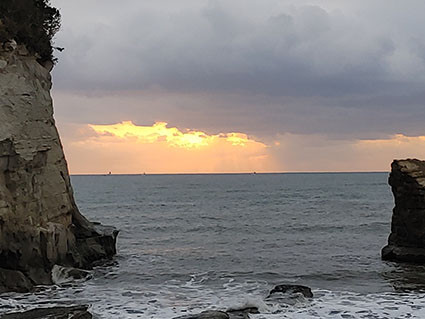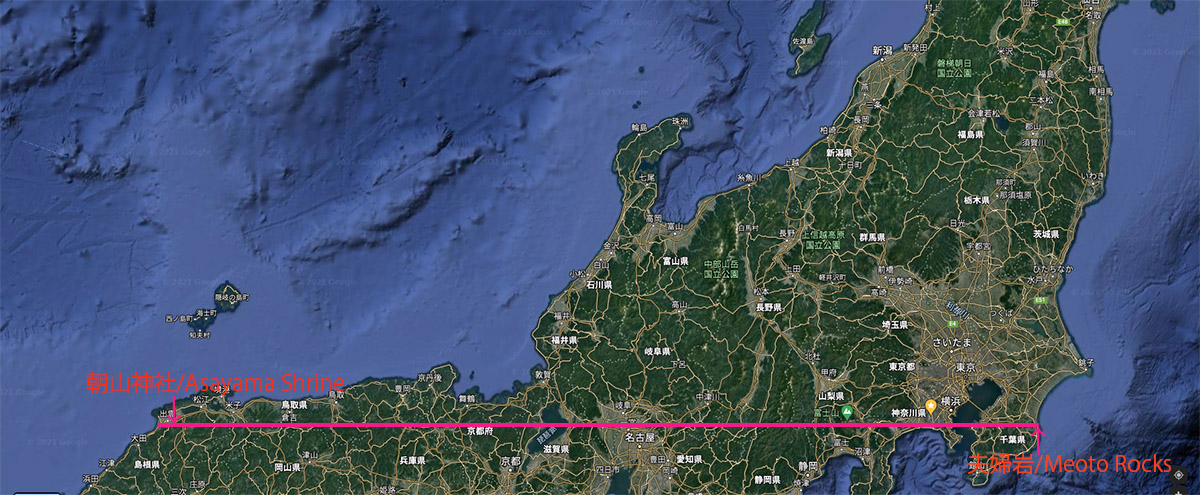
The Rising Sun between ‘Meoto Rocks’ at six in the morning on March 20, Vernal Equinox Day 2021
�v�w�₩��̓��̏o�@4��20���ߑO6���F2021�N�t���̓��@Photo by Kentaro Chiba
�P�F�o�_�_�b
���̃��C���ɂ͊���̐_�b�A�`���A���j���d�Ȃ��Ă���A���̏����Ɋւ��A�����𐬂��Ă���ƍl������͏o�_�_�b�ł���B����10����_�����ƌ������A�o�_�n���ł͐_���ƌĂ�Ă���A���̎����ɂ͏o�_��ЂɑS���̐_�l���W�����A�卑�喽�ւ̕\�h�K�₪�s���邪�A�_�l�̏o�_�ł̍ŏ��̏W���n�_�����̃��C���̐��[�ɂ��钩�R�_�Ђł���B��̃��C���̐������N���b�N�����(27�̒n�}�ɕ�������Ă���)���ꂼ��̒n�_�̊g��n�}������������B�e�X�N���[���n�}�̉��ɂ͏d�v�Ǝv����|�C���g�����������A�����ɂ��Ď����Ȃ�̃R�����g���������������ݎn�߂��B�t���A�H���ɑ��z���܂�����������ʉ߂��邱�̃��C���i�ܐ��j�͖[�������݂���A�o�_�ւ̐_�X�̉��H�ł���A�A�H�ɂ��Ă͖����_�Ђ��N�_�Ƃ���t����{���̋ʑO�_�Ђ��_�Ƃ��郉�C�����ʂɗp�ӂ���Ă���ƍl����B���ꂪ
���C���A�̕��H35��22��30��N���C���ŁA���̖����_�Ђɂ͋A���O�ɐ_�l���W������ƌ����Ă���B�܂��L�I�G�s�\�[�h�Ƃ��Ă̓��}�g�^�P���̔����z���̃G�s�\�[�h���������ł��̃��C���Ō������A��a����̓����ւ̐��͊g��Ƃ̊ւ�肪���肳���B
1:Izumo mythologies
On this alignment there are several mythologies and legends and histories are layered but the earliest and fundamental layer must be related to Izumo mythologies. In October, used to be called Kanna-Zuki, meaning the month of gods�f absence but only in Izumo province it has been called Kamiari-Zuki meaning the month of gods gathering. According to Izumo mythology, gods are supposed to be summoned to Izumo Tisha Shrine to make a courtesy call on Ookuninushi-mikoto, the god of Izumo Taisha, Asayama Shrine has been considered as the first gathering place for gods from all over this country just before their visitants to Izumo taisha.
Regarding gods�f returning home, another line is prepared whose departure point is Makuse Shrine, where gods are supposed to gather before their returns and its terminal is Tamasaki Shrine in Ichinomiya Town, Chiba prefecture. This is
line �A, the homeward 35�� 22�� 30�� N line.
The main building of Asayama Shrine is exactly located on the latitude point as the same point of the middle of Meoto rocks�f entrance beyond 692.74 km. This is a long scroll map separated into 27 pieces on which I listed and will list up new points, which seem to be related to and I am adding my personal comments. If you click on the line divide into 27 parts above, you will experience this line closely. I hope you will note that when each scroll map appears, its leftmost part is always coming. Each scroll map is too large to be shown its whole image, but you can scroll it freely with an arrow key on the bottom.
�Q�F��F�c�q�[���������S�`��/�����ƕ���̃��C��
��F�c�q��672�N��
�p�\�̗��̔s�k�㎠��Ŏ��Q�����Ɛ��j�ɂ͋L�^����Ă��邪�A�[�������e�n�ɂ͌Â������F�c�q���S�`�����`���A���ꂼ��̏ꏊ�ł̌����`����A���J�Ȃǂ��݂��ɊW�������A�[�������S�̂ŁA�l�b�g���[�N���\�����A��ѐ��̂���X�g���[���`�����Ă���̂ŁA���̓��S����^���Ɏ~�߂�w�҂������ƕ����B�܂��L�c�L��̏���
�u��F�̍c�q������v�����̓`���Ɋ�Â��ď�����Ă���B����35��19��10��N���C����ɂ������̑�F�c�q�ɂ܂��_�ЁA��Ղ�����B�������A�p�\�̗��ȑO�ɑn�����ꂽ�_�ЁA�Õ��������C����ɑ��݂��Ă��̂ŁA���C���̐ݒ��ɔs�҂ł����F�c�q�̈ԗ�A�������͕���̈Ӗ����t�����ꂽ�̂����m��Ȃ��B�܂���F�c�q�����ł͂Ȃ��A�Ⴆ�Ί��q�ɂ͊��q���{�I���̒n�ł���k�������̕���₮��
N.03�A���ꌧ�Č��s�ɂ͂�͂�k�����̗L�͕����ł���A�Ō�̘Z�g���T��k���̖k�𒇎��ƈꑰ�Y�}�����n�����@�؎��A����ɁA���s�ɂ͊փ����ŕ��킵����J�g�p�̎��
N.15���݂�B���ɂ����ӂ̂����Ɏ��l���ɂ䂩��̂���ꏊ�����C����Ɍ����邱�Ƃ��ł��邪�A����͒P�Ȃ���R�ł͂Ȃ��A���̃��C�����ŏ��ɐ��ʉ����ꂽ���̂ɁA���
���M���Ƃ��āA�s�҂����̈ԗ�A����̖�����S���ė����̂����m��Ȃ��B�܂�
���H���C���A-N.14�ɂ����l�ɁA���_�Ёi��������j�Ձj�r�R�Õ��i�`�V�t�F���揊�j������B�܂�
���C���A-N.15�ɂ͊փ����Ð�ꂪ����A�Γc�O���̐w�Ղ�����B�����͎O���I���̒n�ł͂Ȃ����A���̒n��I�������͎̂O�����g�ł���̂ŕ���Ƃ͖��W�ł͂��邪�A�k�����I���̒n�A�������Ձi����₮��j�Ƃ̕s�v�c�ȉ^���̕��������C���ɂ���ĈÎ�����Ă���悤�ȋC������B
2: The legend of Prince Otomo�fs escape and demise in Boso peninsular:
After the defeat of Jinshin war in 672, It was officially recorded that
Prince Otomo killed himself in Shiga pref. area in Nihon Shoki, the oldest Chronicles of Japan. However, in Boso area, there are lots of legends of Prince Otomo’s escape remained and these stories have been told in many different places and shrines and temples for 1300 years. Those stories and ceremonies at shrines relate to each other and creating a constellation of a consistent tragic story so even some academic scholars believe that these legends would be reflecting historical fact. The historical novel, �ePrince Otomo�fs Escape to the west�f by Aritsune Toyoda was based on this legend. On this line, especially in Chiba prefecture, you will see several shrines and ruins connected to Prince Otomo. But in Chiba pref. there are lots of Kofun and shrines which were allegedly built before Jinshin war in 672, It means before 672 this alignment was already set, and then a new mission might have been added on this alignment to comfort and seal Prince Otomo’s soul after Jinshin war. You will find another spots where other historical tragic figures died in despair and hopelessness on the line. I guess, it might be possible to think this line has taken missions to console and seal those defeated souls as
Goryo Worhip since Jinshin war in 672 because of the sanctity of the line.
3�F���R�_�ЂƂ̊ւ��
�@�����������̃��C�����ŏ��Ɉӎ��������������͂���T�C�N���X�g�̃u���O�̒��ɁA�����_�Ёi�_�ސ쌧��钬�j
N.04�ƕU�c���R�_�Ёi��t���N�Îs�j
N.02�����ܓx�ɂ���Ƃ����L�q���݂��������o��������ł���B���̃u���O�ɂ��ƁA��鍂���_�Ђɂ͔��R�_�Ђ��J���Ă���A�p�\�̗��Ŕs��������F�c�q�̗���������S���Ă���Ƃ̂��Ƃł������B�n��̓`���ő�F�c�q�̗˂�����ƐM�����Ă����t���N�Îs�̕U�c���R�_�Ђ͕������鑤�ł��邪�A����ł͂Ȃ����R�_�Ђł������̂ł��낤���B�܂����̃��C�����g������ߒ��Ń��C����ɕ����̔��R�_�Ђ����������A���R�_�Ђ͓�̑����_�ЂƂ��ėL���ł���A�n���l�i���N�����n�j�����Ƃ̊ւ����[���B�������A���R�_�Ђ͒��N�����̒��ł�
�V���n�ł���ƌ����A����A��F�c�q�͕�
�V�q�V�c�̑ォ��V���ɖłڂ��ꂽ
�S���n�Ƃ̂Ȃ��肪�����A�S�ϖŖS����S�ύċ���ژ_�ވ�b���߂��ɒu�����ƍl������B�܂�p�\�̗���A���҂ł���
�V���V�c���͑�F�c�q�̌����邽�߂ɍc�q�䂩��̒n�ɐV���n�̔��R�_�Ђ�u���A���̌�ēx���͂̋t�]�ic.f.
��49��E���m�V�c�ւ̍c�ʌp���`�V���n����V�q�n���j���N����A���R�_�Ђ̃X�e�[�^�X�ɂ��ω����������̂����m��Ȃ��B������R�M���͍̂��ł������̐l�X�ɂ���Ďx������A����Ă���A�����ɂ����Ă�����E�z�O�E���Z�𒆐S�ɔ��R�O�k�̗͂�15���I�㔼�̉���̈���Ꝅ�̐헐�Ő��ނ���܂ŁA����ł������̂ŁA��G�c�ő��}�Ȋ��z�͍T����ׂ��ł��낤���A���R�_�Ђ����j�̒��ŁA�֊��Ƃ���Ă������������̐[���ɕ����ė������Ƃ͎����ł���B����������2000�N�ȍ~�A
�O�c���v���ɂ�锒�R�_�Ђ̓�ɐ��ʂ�����g�������������o�ł���A���A�Q���I�[�v���ȋc�_���n�܂����悤�ȋC������B��������̃X�N���[���̓W�J�A�����ƂƂ��ɂ��̃��C���Ɣ��R�_�Ђ̊ւ��ɂ��Ď��Ȃ�ɍl���čs�������B
3:Relationship with Hakusan Shrine and immigrants from Korean Peninsula
I accidentally found a cyclist’s blog where the relationship between Takaku Shrine
N.04in Oiso town, Kanazawa pref. and Hakusan Shrine
N.02in Tawarada, Chiba pref, and the fact that they are both located on the same latitude point were explainded. This story made me excited and taken to these alignments. According to this blog, Takaku Shrine has been charged with a secrete mission to calm and seal
Prince Otomo’s resentful soul as I explain above, but it is a mystery why Hakusan Shrine has related to Prince Otomo. Hakusan Shrine has been considered as quite mysterious and tabooish in Japanese history and has allegedly had a close relation with immigrants from Korean peninsular as the same as Takaku Shrine. Recently, open and free discussion about Hakusan Shrine seems to have been released and easier since Hayao Maeda’s books on Hakusan Shrine published in 2000, but it is true that some of Hakusan shrines has been still forced to be connect to secrecy and taboo in this country for a long time. So being conscious of avoiding hasty comments, I would like to slowly slowly and deliberately improve my thought about this issue as the scroll map is growing.


